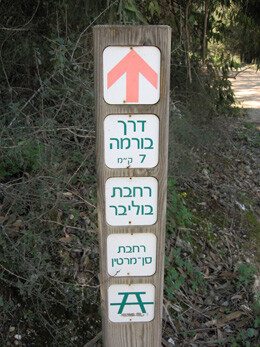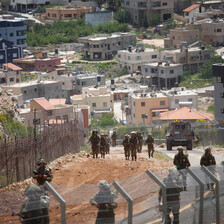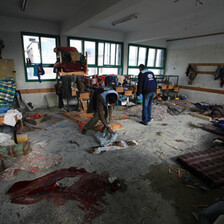The Electronic Intifada 13 August 2009

The sign leading to Bolivar and San Martin courts. (Rahela Mizrahi)
Since its inception in 1901, the JNF has been a key player in the dispossession of Palestinians and the colonization of their homeland. As Uri Davis notes in his book Apartheid Israel, the 1953 Jewish National Fund Law and the 1961 Covenant between the government of Israel and the JNF are central to the Israeli legal apartheid system that “nationalizes” privately-owned Palestinian property.
Despite this history, JNF has offices in the capitals of Bolivia and Venezuela where they raise funds to further entrench a racist system and to erase the signs of Israel’s double crime: the ethnic cleansing of Palestine and the demolition of the Arab Jewish communities all over the Arab world and the transfer of Jews of Arab origin to Palestine by means of deception and terror.
After demolishing most of the Palestinian villages in the territory now called Israel, the Zionist movement housed the transferred Jews of Arab origin in some of the villages and the JNF employed them in the planting of pine forests over the ruins of the Palestinian villages.
Together, the Jewish National Fund Law and the Covenant define 93 percent of the entire territory that Israel occupied in 1948 as “national lands” legally designated for those persons who are defined under the laws of the State of Israel as “Jews.” This effectively places these lands off limits to the indigenous Palestinian population, carrying out a sort of legal ethnic cleansing. In addition, the JNF has been instrumental in veiling the ruins of many, if not most, of the Palestinian localities ethnically cleansed by the Israeli army in the course of and in the wake of the 1948 war. According to Uri Davis, it accomplishes this task by planting forests and developing recreational facilities on the lands they have cleansed, and over their remains.
A prime example of the double crime being committed by the Zionists is Eshtaol Forest. Most of the Eshtaol Forest covers the lands of the two Palestinian villages: Islin, where 280 inhabitants used to live, and Ishwa, formerly home to 680 Palestinians. The inhabitants of these lands were expelled by the Harel Brigade of the Palmach militia, which departed from Kibbutz Zoraa the morning of 18 July 1948. The Eshtaol forest also resides on the lands of two other villages: Beit Mahsir, where 2,620 inhabitants were expelled on 11 May 1948, and Beit Susin, where 230 inhabitants were expelled on 20 April 1948.
In Eshtaol Forest, there stand three courts. The first one is dedicated to the memory of Simon Bolivar, the revered 19th century liberator of Latin America from European colonialism; it stands on the land of the village Ishwa. The other two courts are dedicated to another liberator of Latin America from the same period, General Jose de San Martin; they stand on the land of Beit Mahsir.
Moshav (the Zionist term for village) Eshtaol, built on the ruins of Ishwa, is a village of immigrants from Yemen, who were transferred by the Zionist movement to Palestine right after the 1948 ethnic cleansing. In the transfer camp in Sana, Yemen’s capital, the Zionist Agency looted more then 50 tons of the Yemeni Jewish community’s ancient sacred books and manuscripts and many tons of goldsmithing, a craft in which they specialized. In the transfer camp, children were kidnapped and were delivered to European Jewish families for adoption. Once in Moshav Eshtaol, and in the neighboring Moshav, Yishi, which has an identical story, the community succeeded in restoring a part of life as it was in Yemen.
The return of the Palestinian refugees to their land does not necessarily mean another dispossession of this community. On the contrary, it may provide an opportunity to establish neighborhood relationships that will fix the wrongs that were done both to the Palestinian refugees and Jews from Arab countries by a European settler-colonial movement. Meanwhile, it would fortify the culture of the Yemeni Jewish community of Moshav Eshtaol and Moshav Yishi, which were always fed by Arab and Muslim civilizations in their country of origin. It might also serve to strengthen their Arab dialect of Hebrew, a dialect and culture under threat of extermination by the Israeli Zionist Ashkenazi establishment.
Only when these historic injustices are rectified, can the use of these revolutionary heroes’ names be justified. Until that time, those concerned with social justice should pressure the governments of Venezuela and Bolivia to kick the JNF out of their cities.
Rahela Mizrahi has a degree in fine arts from the Betzalel Academy in Jerusalem and is currently completing her second degree, writing on the “Patterns of Expropriation, Conversion, and Appropriation of Palestinian Heritage through Israeli Art” at Tel Aviv University. A version of this essay was originally published by the International anti-Zionist Network: http://www.ijsn.net/398/.





